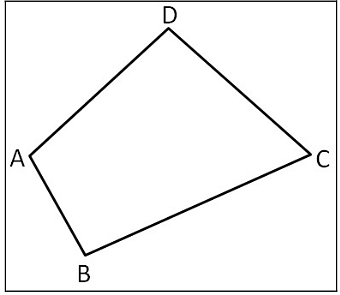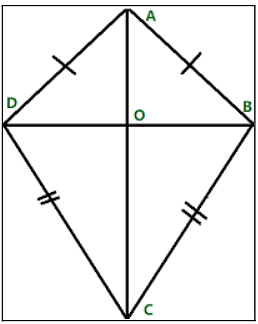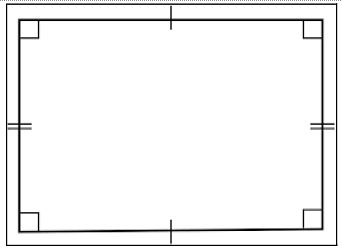
Jasmine Grover Content Strategy Manager
Content Strategy Manager
A Quadrilateral is a closed shape that is known to have sides of different measures and different lengths. It is a two dimensional closed shaped polygon having four vertices, four angles and four sides. Trapezium, Parallelogram, Rectangle, Rhombus, Square and Kite are some of the examples of Quadrilateral.
The concept of quadrilateral was introduced by the Greek Mathematician, Euclid in his Euclidean Plane Geometry. The word quadrilateral has been derived from two separate Latin words- “Quadri” which means ‘a variant of four’ and “latus” which means ‘side’. Quadrilaterals can be both simple and complex-type. If we consider any quadrilateral, say ABCD, then the sum of all its interior angle (of a simple quadrilateral) will be 360°. This is known as the Angle Sum Property of a Quadrilateral. There are various types of Quadrilaterals such as Trapezium, Parallelogram, Rectangle, Rhombus, Square and Kite.
| Table of Contents |
Key Terms: Quadrilateral, Polygon, Shape, Vertices, Side, Angles, Parallelogram, Rectangle, Trapezium, Rhombus, Square, Kite, Properties, Edges, Symmetry
What is a Quadrilateral?
[Click Here for Sample Questions]
A Quadrilateral can be defined as a polygon with 4 vertices and 4 sides enclosing 4 angles. The sum total of all the interior angles of a quadrilateral is 360 degrees which means
∠A+ ∠B+∠C+ ∠D = 360°

Quadrilateral
Types of Quadrilaterals
[Click Here for Sample Questions]
Based on the different sides, angles, edge and vertices formed by quadrilaterals, there are six different variants of quadrilaterals present in geometry, they are:
- Parallelogram
- Trapezium
- Rhombus
- Kite
- Rectangle
- Square

Types of Quadrilateral
Properties of Quadrilaterals
[Click Here for Sample Questions]
The various types of quadrilaterals and their properties are:
Parallelogram
A parallelogram is a kind of quadrilateral that has both its sides parallel to each other. The sides and lengths of a parallelogram will be always equal to each other. Let us consider a parallelogram ABCD, and here we can see that AB and CD are equal sides, then AB=CD.
If we draw two diagonals AC and BD, we see that the diagonals intersect each other at their mid-points. If we name the mid-point as E, the length AE=CE and BE=DE
The consecutive angles of parallelogram ABCD will be supplementary opposite angles of the parallelogram will also be equal, i.e. 180°.
- Number of vertices present: 4
- Number of edges present: 4
- Area: Height x Base
- Perimeter: 2 x sum of the lengths of adjacent sides
- Line of symmetry: 0
- Properties A Parallelogram has parallel and congruent opposite sides. The diagonals intersect each other at a midpoint. Hence, the opposite angles are congruent and also equal.

Parallelogram
Check More: Introduction to Three-Dimensional Geometry
Trapezium
A trapezium is a quadrilateral that has one side parallel to its opposite side. Let us consider a trapezium ABCD, where side AB is parallel to side CD.
- Number of vertices present: 4
- Number of edges present: 4
- Line of symmetry: 0
- Area: ½ x perpendicular distance x sum of the lengths of parallel sides
- Properties: When the one set of opposite sides is parallel to each other, the sum of the adjacent angles for a convex polygon will be 180°.

Trapezium
Rhombus
Rhombus is a kind of quadrilateral with all four sides of equal lengths. Here, the opposite angles are equal and the opposite sides are parallel to each other.
- Number of Edges: 4
- Number of Vertices: 4
- Area: pq/2, [p and q are the two diagonals]
- Perimeter: 4 x side of the rhombus
- Properties: In a closed convex polygon, where the diagonals are congruent, perpendicular and intersect each other, the opposite angles are equal.

Rhombus
Kite
Kite is another type of 2-D shape which is having two pairs of equal sides and four edges. The sides of a kite are adjacent to each other. This type of shape can be concave or convex.
- Number of Edges: 4
- Number of Vertices: 4
- Area: ½ x product of the length of the diagonals
- Line of Symmetry: 1
- Rotational symmetry: 1
- Perimeter: 2 x sum of the length of sides
- Properties: A rhombus has two consecutive sides & congruent pairs, perpendicular diagonals and congruent non-vertex angles.

Kite
Rectangle
In the case of a rectangle, it has all the four angles of the same measure, right angles i.e. 90°. The opposite sides of a rectangle are parallel to each other and are of the same lengths. It is also said to be a parallelogram as all its interior angles are right angles.
- Number of Edges: 4
- Number of Vertices: 4
- Area: Length x Breadth
- Perimeter: 2 x (Length + breadth)
- Internal Angles: 90°
- Properties:
- All the four angles are - 90°
- Opposite sides are equal and parallel to each other
- Diagonals bisect each other

Rectangle
Square
A type of Quadrilateral that has all its four sides equal, i.e. 90° is called a square. It is also said to be flat-shaped which looks like a rectangle having equal lengths of its two adjacent sides.
- Number of Edges: 4
- Number of Vertices: 4
- Area: (Side)2
- Perimeter: 4 x side
- Internal Angles: 90°
Properties:
- Diagonals are equal
- All four sides are also equal
- The four angles have an equal measure that is 90°
- Opposite sides have equal lengths and are parallel to each other
- Diagonals bisect each other and meet at an angle of 90°
- The diagonals bisect its angles

Square
Read More: Difference between Area and Volume
Things to Remember
- A closed shape having 4 sides is termed a Quadrilateral.
- Quadrilateral consists of all the internal angles whose sum is 360°
- The properties of a quadrilateral are what help it to differentiate it from the other types of polygons
- Trapezium, Parallelogram, Rectangle, Rhombus, Square and Kite are examples of Quadrilateral.
- Different types of Quadrilaterals have different properties as mentioned above.
Sample Questions
Ques. How can you show that the diagonals of a square are equal and bisect each other at 90°? (5 Marks)
Ans. If we consider a square ABCD, and the two diagonals AC and BD,
We need to prove that AC=BD and AC bisect BD at 90°
In ΔBAD & ΔABC,
AB=AB (which is a common line)
AD=BC (opposite sides)
∠BAD = ∠ABC = 90°
Using the SAS property, ΔABC ≅ ΔBAD
So, By CPCT,
AC=BD
Similarly, in ΔOAD & ΔOCB,
∠OBC= ∠ODA (transversal BD)
∠OCB = ∠OAD (transversal AC)
ΔOCB ≅ ΔOAD (Using ASA Property)
Hence, OB = OD ----- (1) & OA = OC ------ (2)
So, from (1) & (2) we get that diagonals AC & BD bisect each other
Now ΔODA & ΔOBA,
BA = DA [OB=OD (from (2))]
OA = OA (being the common line)
Using CPCT,
ΔAOD = ΔAOB ------ (3)
∠AOD + ∠AOB = 180° (both the angles are linear pair)
2 ∠AOB = 180°
∠AOB = ∠AOD = 90°
Hence, we can see the two diagonals AC & BD bisect each other at 90°.
Ques. What is the area and perimeter of a rectangle? (2 Marks)
Ans. The area and perimeter of a rectangle are:
- Area: length x breadth (L x B)
- Perimeter: 2 x (L + B)
Ques. What are the measures of the three angles of a quadrilateral, if its fourth angle is 144° and all angles are equal? (3 Marks)
Ans. Let us consider each angle as x of a quadrilateral.
As we already know the ‘sum of all the interior angles of a quadrilateral is 360°’.
So, x + x + x +144° = 360°
3x + 144° = 360°
3x = 360° - 144°
3x = 216°
x = 216° / 3
x = 72°
Hence, the measure of the three sides of the quadrilateral is 72°.
Ques. In a given parallelogram ABCD, find the value of ∠A + ∠C. The value of ∠B is given as 100°. (3 Marks)
Ans. Given, ∠B = 100°
As the sum of the interior angle of a parallelogram is 180°
∠A + ∠B = 180°
∠A + 100° = 180°
∠A = 180° - 100°
∠A = 80°
Therefore, the opposite angles of a parallelogram are equal.
So, ∠A = ∠C = 80°
∠A + ∠C = 80° + 80°
= 160°
So, the measure of ∠A = 80°; ∠C = 80° & ∠D = 160°
Ques. How is a quadrilateral considered as a parallelogram? (3 Marks)
Ans. A quadrilateral can be said to be a parallelogram when,
- The opposite sides of a quadrilateral are equal
- The diagonals of the quadrilateral bisect each other
- The opposite sides of a quadrilateral are also equal
Ques. How will you identify a Rhombus? (3 Marks)
Ans. A rhombus will be having its angles which will not be equal to 90°.
- The rhombus is a quadrilateral that also looks similar to a diamond.
- The rhombus has its parallel opposite sides and the lengths of all the sides are similar.
- Rhombus can be also called as “Equilateral Quadrilateral”.
Ques. In a square ONKA, what is the value of ∠KOA, if ∠KON is 45°. (3 Marks)
Ans. Given, square ONKA, ∠AON will be 90°
If a diagonal bisects the square at ∠s
Hence, ∠AON = ∠KON = 45°
So, the measure of ∠KOA is 45°
Ques. If ∠A and ∠B measures 55° & 70° respectively of a trapezium ABCD, find the value of ∠C & ∠D. (3 Marks)
Ans. Given that ∠A = 55° and ∠B =70°
The sum of the ∠A + ∠D = 180°
So, 55° + ∠D = 180°
∠D = 180° - 55°
So, ∠D = 125°
In same manner,
∠B + ∠C = 180°
70° + ∠C = 180°
∠C = 180° - 70°
So, ∠C = 110°
Read More:






Comments